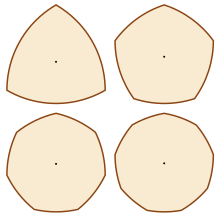Barbier's theorem

In geometry, Barbier's theorem states that every curve of constant width has perimeter π times its width, regardless of its precise shape.[1] This theorem was first published by Joseph-Émile Barbier in 1860.[2]
Examples
The most familiar examples of curves of constant width are the circle and the Reuleaux triangle. For a circle, the width is the same as the diameter; a circle of width w has perimeter πw. A Reuleaux triangle of width w consists of three arcs of circles of radius w. Each of these arcs has central angle π/3, so the perimeter of the Reuleaux triangle of width w is equal to half the perimeter of a circle of radius w and therefore is equal to πw. A similar analysis of other simple examples such as Reuleaux polygons gives the same answer.
Proofs
One proof of the theorem uses the properties of Minkowski sums. If K is a body of constant width w, then the Minkowski sum of K and its 180° rotation is a disk with radius w and perimeter 2πw. The Minkowski sum acts linearly on the perimeters of convex bodies, so the perimeter of K must be half the perimeter of this disk, which is πw as the theorem states.[3]
Alternatively, the theorem follows immediately from the Crofton formula in integral geometry according to which the length of any curve equals the measure of the set of lines that cross the curve, multiplied by their numbers of crossings. Any two curves that have the same constant width are crossed by sets of lines with the same measure, and therefore they have the same length. Historically, Crofton derived his formula later than, and independently of, Barbier's theorem.[4]
An elementary probabilistic proof of the theorem can be found at Buffon's noodle.
Higher dimensions
The analogue of Barbier's theorem for surfaces of constant width is false. In particular, the unit sphere has surface area , while the surface of revolution of a Reuleaux triangle with the same constant width has surface area .[5]
Instead, Barbier's theorem generalizes to bodies of constant brightness, three-dimensional convex sets for which every two-dimensional projection has the same area. These all have the same surface area as a sphere of the same projected area.
And in general, if is a convex subset of , for which every (n−1)-dimensional projection has area of the unit ball in , then the surface area of is equal to that of the unit sphere in . This follows from the general form of Crofton formula.[6]
See also
- Blaschke–Lebesgue theorem and isoperimetric inequality, bounding the areas of curves of constant width
References
- ^ Lay, Steven R. (2007), Convex Sets and Their Applications, Dover, Theorem 11.11, pp. 81–82, ISBN 9780486458038.
- ^ Barbier, E. (1860), "Note sur le problème de l'aiguille et le jeu du joint couvert" (PDF), Journal de mathématiques pures et appliquées, 2e série (in French), 5: 273–286, archived from the original (PDF) on 2017-04-20. See in particular pp. 283–285.
- ^ The Theorem of Barbier (Java) at cut-the-knot.
- ^ Sylvester, J. J. (1890), "On a funicular solution of Buffon's "problem of the needle" in its most general form", Acta Mathematica, 14 (1): 185–205, doi:10.1007/BF02413320.
- ^ Bayen, Térence; Henrion, Didier (2012), "Semidefinite programming for optimizing convex bodies under width constraints", Optimization Methods and Software, 27 (6): 1073–1099, CiteSeerX 10.1.1.402.9539, doi:10.1080/10556788.2010.547580, S2CID 14118522.
- ^ Martini, Horst; Montejano, Luis; Oliveros, Déborah (2019), "Section 13.3.2 Convex Bodies of Constant Brightness", Bodies of Constant Width: An Introduction to Convex Geometry with Applications, Birkhäuser, pp. 310–313, doi:10.1007/978-3-030-03868-7, ISBN 978-3-030-03866-3, MR 3930585, S2CID 127264210





